Last Updated: 22/07/2025
How To Trim Your Dog's Nails Like An Expert
Nervous about trimming your dog's nails? Our guide makes it easy. Learn the proper techniques for a safe, stress-free trim at home, turning a dreaded task into a calm bonding experience. We'll show you how to avoid the quick, build your confidence, and keep your pup's paws perfectly healthy.
Author: Dr Gillian Hill BVSc (Hons)
Reading Time: 13 minutes - short read
Do you hear the incessant tap-tap-tap of your dog's nails on the floor as they walk? Have playful greetings turned into a scratch-fest, leaving you with nicks and scrapes? Overgrown nails are not just an annoyance; they're a signal of discomfort for your dog.
Neglected nails can spiral into more than a nuisance too. They can twist paws, snag on carpets, and even cause joint damage, leading to a lifetime of pain and vet visits.
Fear not, because we'll guide you through a step-by-step process to trim your dog's nails safely and comfortably.
Understanding the basics
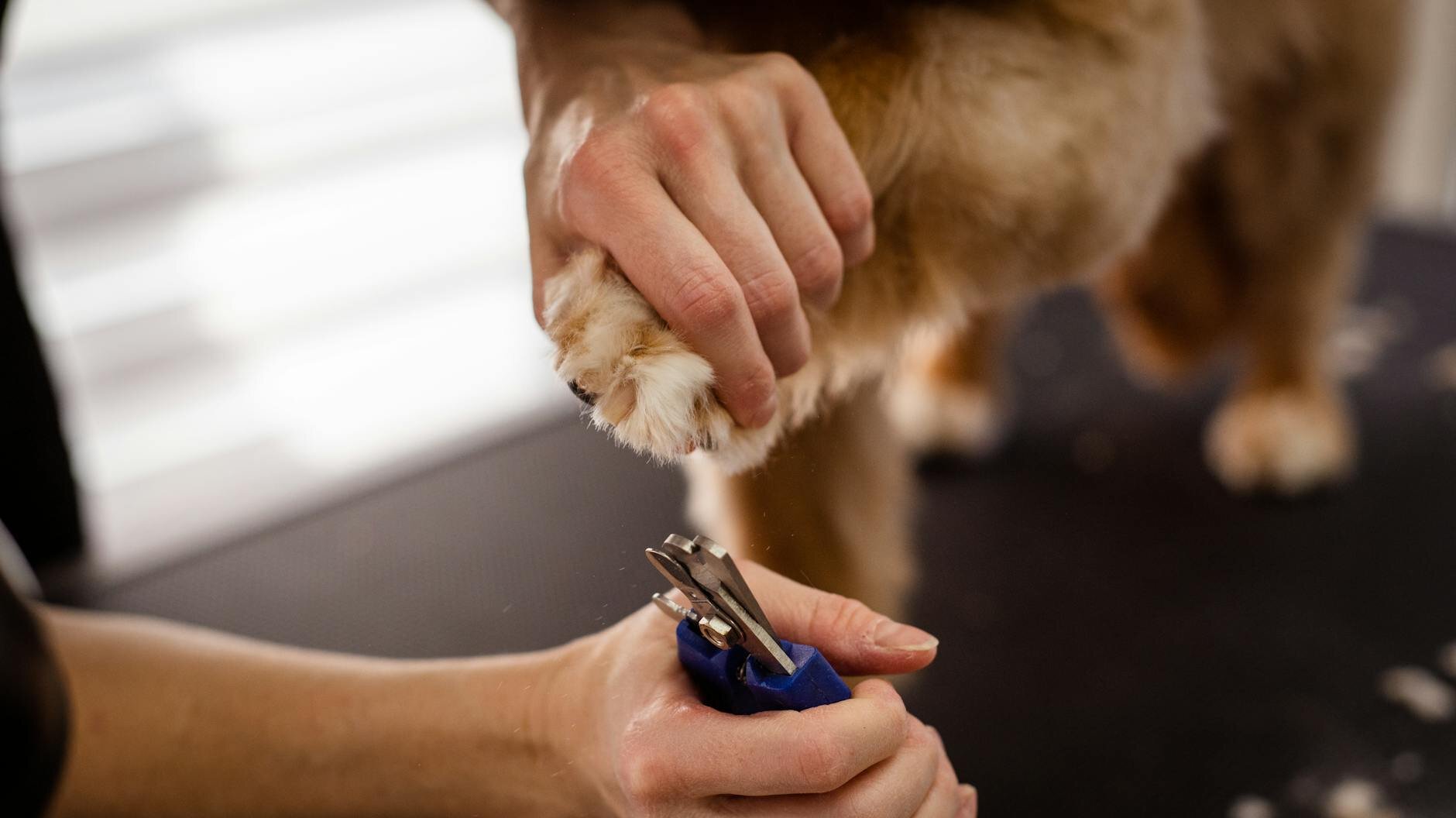
As most dog owners will know, nail trimming is an important addition to a regular grooming schedule, and maintenance of a happy, healthy pooch! But why is nail care so important for dogs? Nail trimming is crucial not only for cosmetic reasons and for sparing your floors and furniture from claw marks, but more importantly to prevent injuries, pain and sometimes permanent damage associated with long nails.
Risks associated with long nails in dogs:
- Breaks and tears from becoming snagged on carpets and fabrics, leading to infection of the nail bed
- Upward pressure on the toes when the long nail comes in contact with the ground, putting excessive force on the paw and leg. This can lead to pain and arthritis
- Splayed toes, which may cause pain, discomfort and altered mobility. This can also lead to a dog favouring that leg, leading to excessive strain and force placed on other legs
- Reduced traction on flooring
- In severe cases, the nail can curve right around and into the paw pad, causing intense pain and risk of infection
Frequency of nail trimming
The frequency of nail trimming will depend on your dog's lifestyle, and to some extent, their breed. Active dogs who exercise frequently on hard surfaces such as bitumen, will naturally wear down their nails more, and so may not require regular nail trims. However, dogs who spend the majority of their time indoors or on soft surfaces like lawns, may need their nails trimmed as often as every week. Certain breeds of dogs such as French Bulldogs and Pugs, or individual dogs with abnormal conformation of their toes, may require more regular nail trims than others. A monthly nail trim would be a reasonable place to start.
Recognising when your dog's nails are too long
How do you know when your dog's nails need to be trimmed? The following factors may indicate that it's time to get those nail clippers out:
- You can hear your dog's nails clicking on hard floors or concrete
- Your dog's nails are touching the ground when they are standing
- The nail is curling around towards the paw pad (especially with dew claws)
Pre-Trimming Preparation
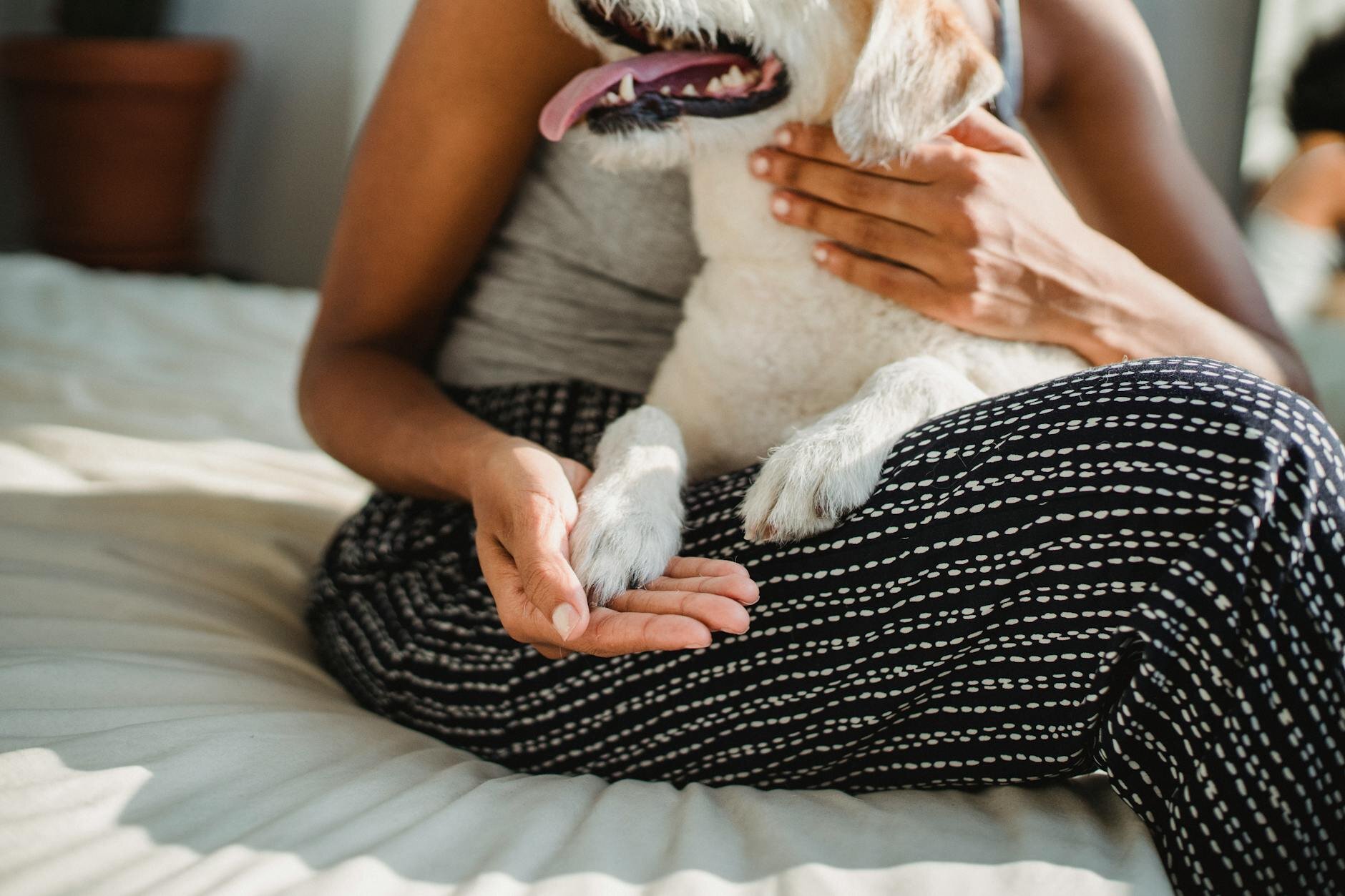
Let's be honest - most dogs dislike having their nails trimmed. This is primarily because they have either had a bad experience with nail trimming in the past, and/or they have not been trained to enjoy nail trimming. That's right - it can be an enjoyable experience for them! The key is in early desensitisation, positive reinforcement and plenty of time and patience!
Acclimatising your dog to nail trimming
Ideally acclimatising your dog to nail trimming starts when your dog is a puppy, but the same process applies with a newly adopted adult dog, or existing dog as well. It all starts with teaching your dog to happily have their paws handled. For puppies who have had no bad experiences, this process may be quite quick, whereas for others the process may take longer.
Desensitisation process for handling the paws
- When your dog is relaxed, gently touch their leg, starting at the shoulder and slowly moving down the leg until you reach a point where they become a little worried (signs may include a tensing of the body, licking the lips, 'whale eye', or ears pulled back (see our guide to How to Read Dog Body Language for lots more information and pictorial guides). This point is called the 'threshold point'.
- With your dog relaxed, touch them briefly and gently and stop at the threshold point, feeding treats non-stop while you keep the touch at the threshold point for 1-2 seconds.
- Repeat step 2 until your dog looks at you, expecting a treat when you touch their threshold location.
- Increase the length of 'touch' time at their threshold point until your dog is completely comfortable for any length of time.
- Gradually move your touch further down the leg, remembering to offer treats non-stop, repeating steps 1-4 at each location.
- When you reach the 'wrist' or 'ankle', start to add a little pressure to the touch, as you would when lifting the paw. This will then progress to lifting the paw off the ground, or holding the paw completely in your hand, and gently squeezing the toes as if you were ready to clip the nail. Keep offering treats.
- Repeat step 6 until your dog is completely comfortable with you handling their paws and toes.
Introducing the nail clippers
- When your dog is completely comfortable with you handling their paws and toes, now it's time to introduce the nail clippers. Take your dog to a location where they are relaxed and comfortable. Without touching your dog, place the nail trimmers down in front of them, allow them to investigate, and offer a treat.
- Bring the nail clippers close to your dog and give them a treat. Repeat until your dog is completely comfortable with the nail clippers nearby.
- Clip a piece of dry pasta with the nail clippers so that your dog can hear and see what's happening, and give them a treat. Repeat until your dog is completely comfortable when hearing the sound of the pasta being clipped.
- Once your dog is comfortable with all the previous steps, try clipping just one nail (see our Step by Step guide below) and immediately give them a treat. Continue only if your dog remains relaxed. If you only clip one nail in each session, that's still a win!
Choosing the right environment for nail trimming
Choosing the right environment for nail trimming for your dog will significantly impact on the experience for both you and them. Some factors to consider when choosing where to trim your dog's nails include:
- Select a quiet and familiar space where your dog feels comfortable, such as a room where they spend a lot of time, or normally have positive experiences like play or treats. If your dog has had negative experiences with nail trimming in the past, avoid going back to those locations again.
- Make sure the area is well lit so that you can see your dog's nail properly.
- Choose a non-slip surface so that your dog has traction and does not feel unstable.
- Minimise distractions, such as from the tv, radio, other pets and household members.
- For many dogs, feeling properly secured is comforting, so don't be afraid to have another person gently but firmly hold your dog during the process. However, if this is stressful for your dog, it's important to stop immediately.
- Have plenty of treats or favourite toys nearby, as well as your nail clippers.
Selecting the Right Tools
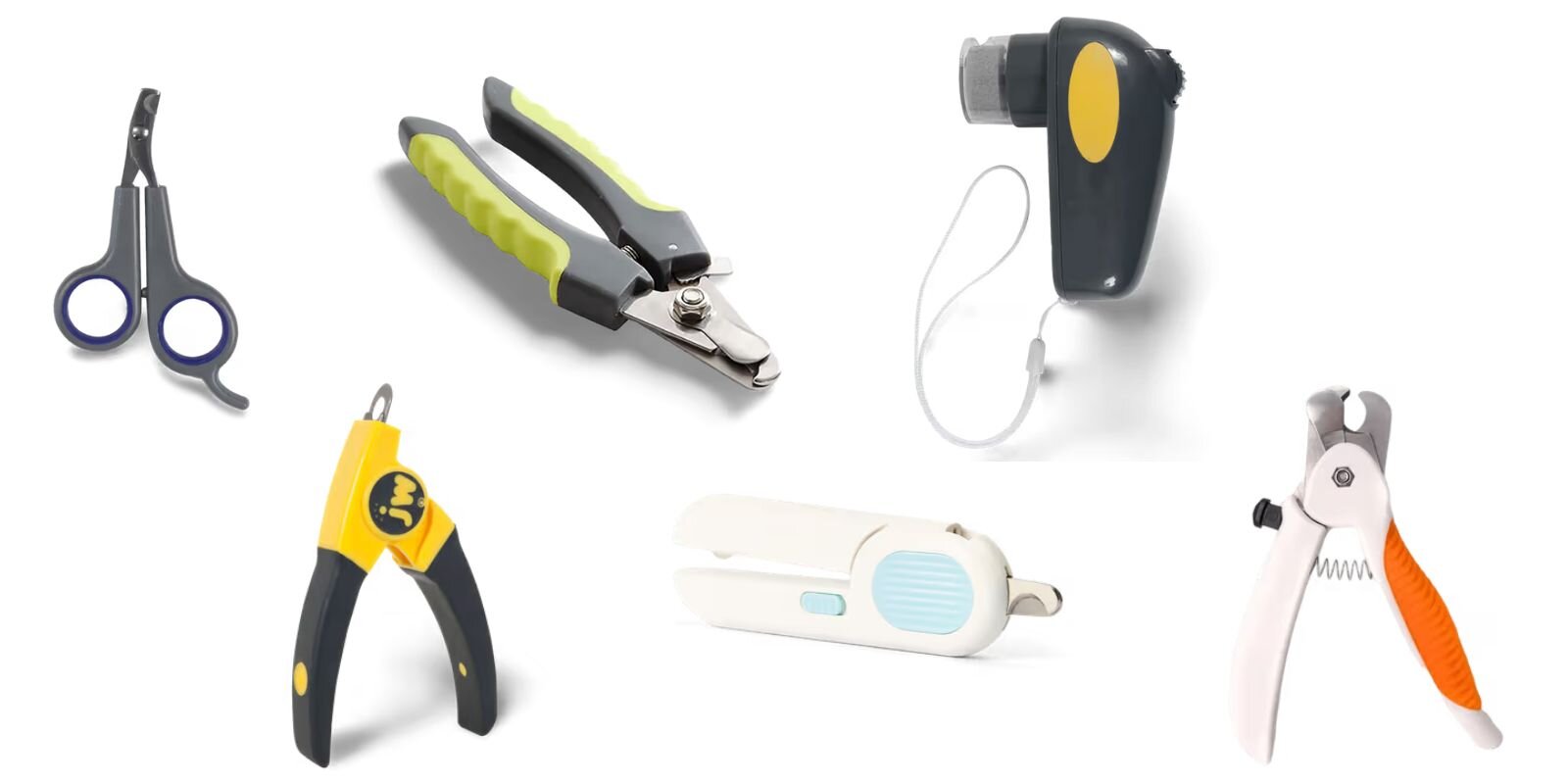
Types of nail clippers
The first step to streamlining the nail trimming process is to choose a pair of nail clippers that suits you and your dog. Generally I recommend scissor-style clippers for their ease of use. For small dogs and cats I would recommend using a small pair of clippers that are suitable for little paws. For medium and large dogs, use a more hefty pair of clippers that are strong enough to cleanly cut through thicker nails.
Some owners may prefer to use a guillotine style nail clipper. Guillotine style clippers require the dog's nail to be placed in the opening so they are easier to use on calm dogs and are better suited for small to medium-sized dogs.
A nail grinder is another alternative. They use a spinning abrasive pad to wear down the nail and smooth out rough edges. Nail grinders have pros and cons compared to traditional scissor or guillotine style nails clippers. They are a great option for dark nails or thick nails that are difficult to cut, or for dogs who have had very bad experiences with nail clippers. However, the noise of the grinder can take more time for dogs to become acclimatised to, so the desensitisation process may take longer. If left in contact with the nail for too long, the nail can become overheated, and will cause pain and damage to the nail. There is also the risk of the grinder coming in contact with the soft tissues around the toe, so care must be taken.
The Nail-Trimming Process
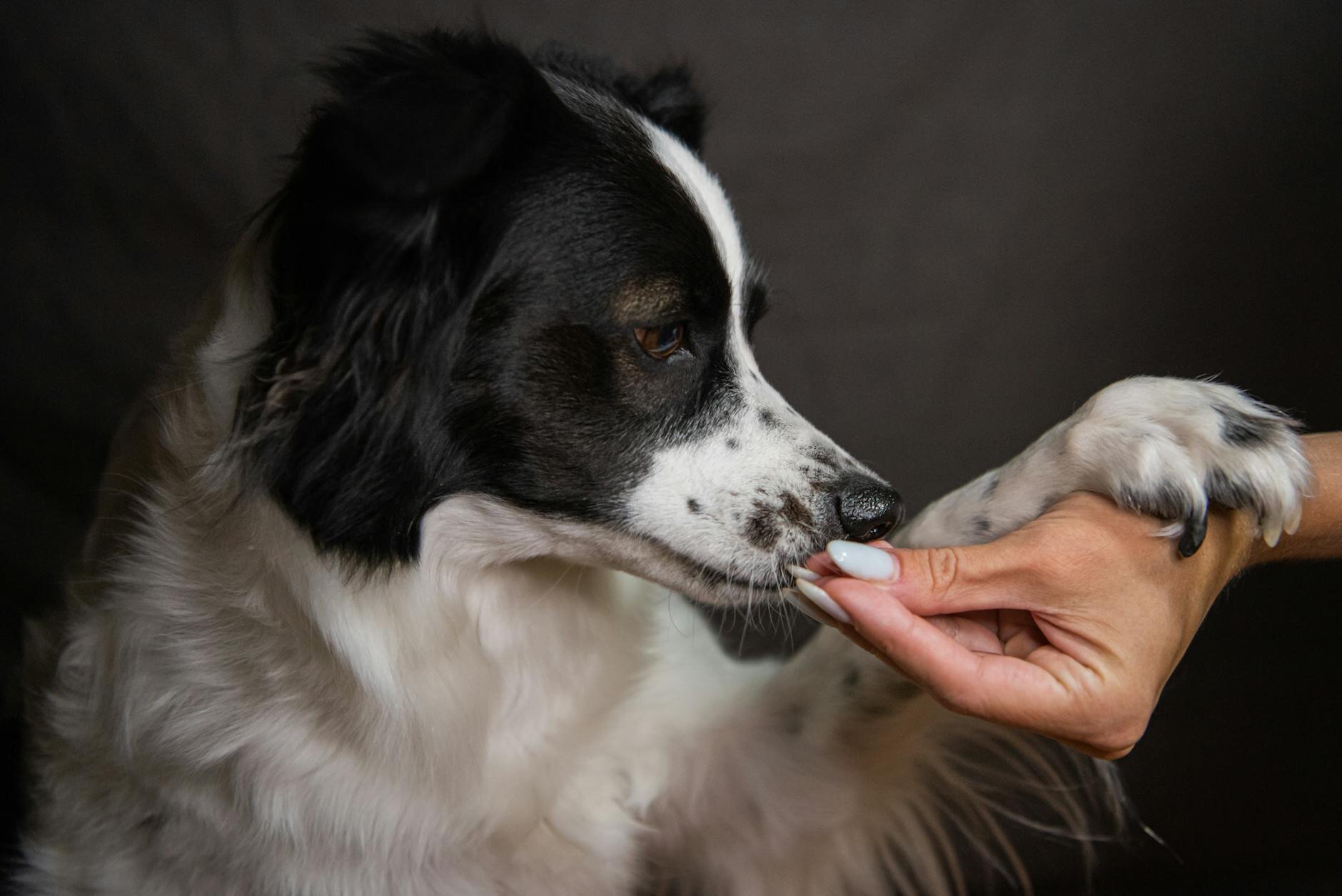
Step by Step Instructions for Trimming the Nails
- Find a comfortable position for you and your dog. This may be you sitting down with your dog in your lap, your dog standing on a table with a helper holding them around the shoulders, a family member holding your dog gently but firmly etc.
- Isolate the toe by gently pressing the top of the toe back with your thumb while pushing upwards on the paw pad from below. This will allow the tip of the nail to rise and separate from the other nails.
- Identify the quick of the nail. In dogs with white or lighter coloured nails, this will be quite easy. The quick is the blood supply of the nail, and appears as a pink channel within the nail. Sometimes shining a torch through the other side of the nail back towards you can help to identify the quick. Cutting the quick can be very painful and result in bleeding, so we need to avoid cutting into this as much as possible. For dogs with dark nails, sometimes it is simply impossible to see the quick, so be sure to trim only slivers off the nail each time.
- Using the clippers, trim small pieces of the nail off, rather than large chunks at a time.
- Try to stick to trimming the thinner, pointy outer part of the nail, rather than into the thicker nail bed - this will help you to avoid cutting into the quick.
- Don't forget to trim or grind the dew claws as well!
Using a nail grinder
- If using a nail grinder, hold the grinder close to the rotating head, to allow more stability and prevent any discomfort to your dog from the grinder's vibration.
- With your other hand, hold back the hair of the paw to prevent it from being caught in the grinder.
- If you have an adjustable speed grinder, start at slower speeds to begin with.
- Grind for only a few seconds at a time to prevent damage.
Frequently asked questions
Professional Help and Alternatives
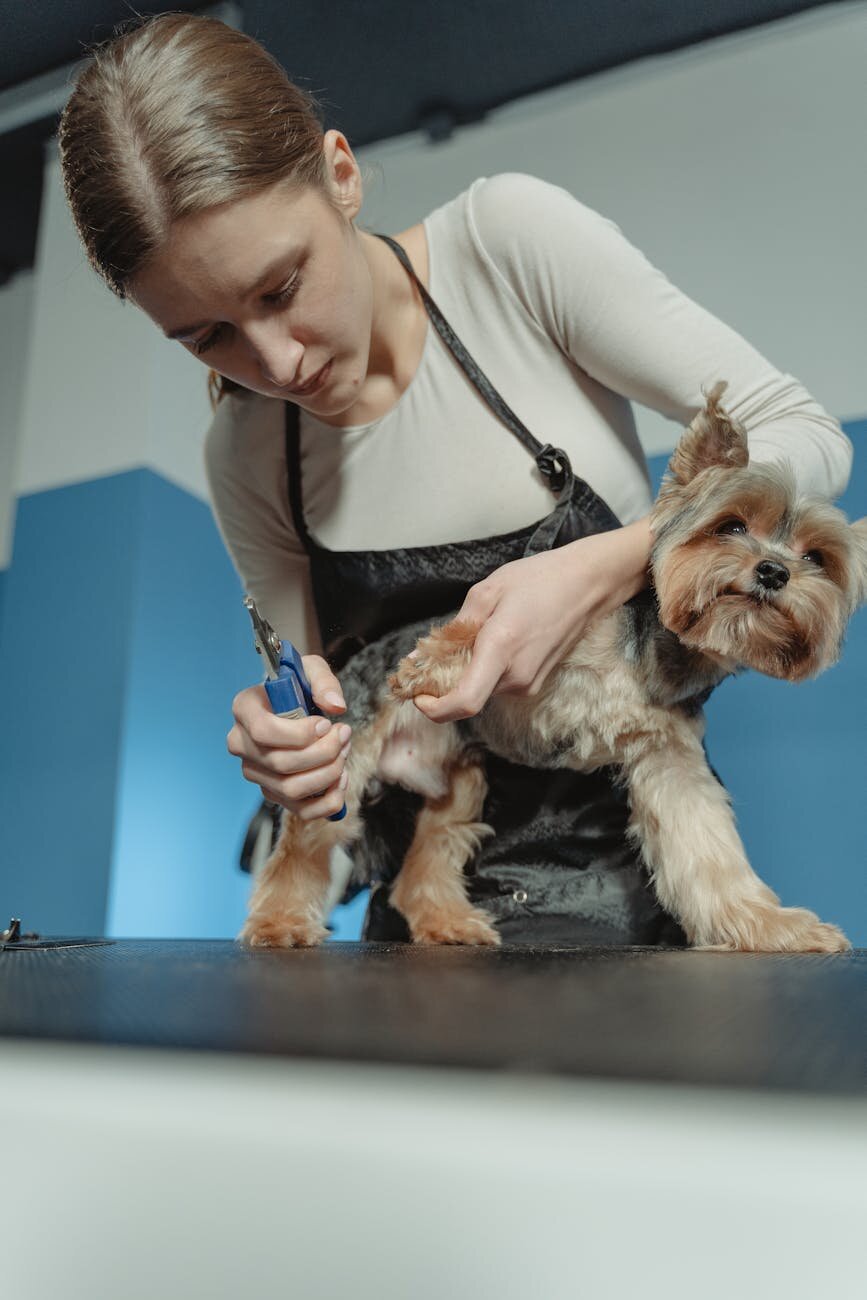
Rest assured that professional help is always available if you or your dog struggle with the nail trimming process.
Seeking professional grooming services for dog nail trimming can be beneficial in several situations:
Nervous or aggressive behaviour
If your dog becomes anxious, aggressive, or overly stressed during nail trimming, a vet or professional groomer experienced in handling such situations can manage the process more effectively and safely. Some dogs do require anti-anxiety products (like Zylkene or Adaptil) or even sedation, to allow their nails to be trimmed. In these circumstances, speaking to your vet about the best course of action that suits your dog is advisable.
Lack of confidence
If you're unsure about how to trim your dog's nails properly or lack confidence in doing so, a vet or professional groomer can demonstrate the correct technique and provide guidance.
Dark or thick nails
Dogs with dark or thick nails may pose challenges during trimming as it's harder to visualise the quick.
Injury or health concerns
If your dog has a history of nail injuries, deformities, health issues affecting their nails or otherwise (such as arthritis), a vet or professional groomer can handle the trimming more delicately and with proper care.
Limited mobility
Dogs with limited mobility due to age, injury, or health conditions might find it uncomfortable or challenging to have their nails trimmed at home.
Time constraints
If you're pressed for time or unable to consistently maintain a regular nail trimming schedule, vets or professional grooming services can ensure your dog's nails are adequately trimmed.
How to trim your pet's nails with Dr Olivia
Check out additional tips from Dr Olivia on how to trim your pet's nails. For more pet care videos, click the button below.
Trimming your dog's nails can seem like an ordeal for everyone involved, but if you take the time to help your dog get acclimatised to having their paws handled, introduce the clippers in a positive way, make the environment conducive to a good experience, and have plenty of patience, it can become a great opportunity to build a stronger relationship with your dog. Rest assured that there is always professional help available should you need it for any reason.
Further Reading
Want to read more? Check out our other articles:
History
Our experts continually monitor the health and wellness space and we update our articles when new information becomes available.
Wed 23 Jul 2025
Edited by Dr Gillian Hill BVSc (Hons)Dr Gillian Hill BVSc (Hons)
Veterinarian
Dr. Gillian loves being able to provide depth and detail to pet parents questions, and give up to date, evidence based advice. She loves the variety of pets and inquiries she receives - she especially loves the 'curly' questions that require some research! Seeing the gorgeous photos that pet parents send through of their babies is a highlight of the day! Gillian enjoys to further her veterinary knowledge, and has completed further training in ultrasonography, behaviour and backyard poultry!

